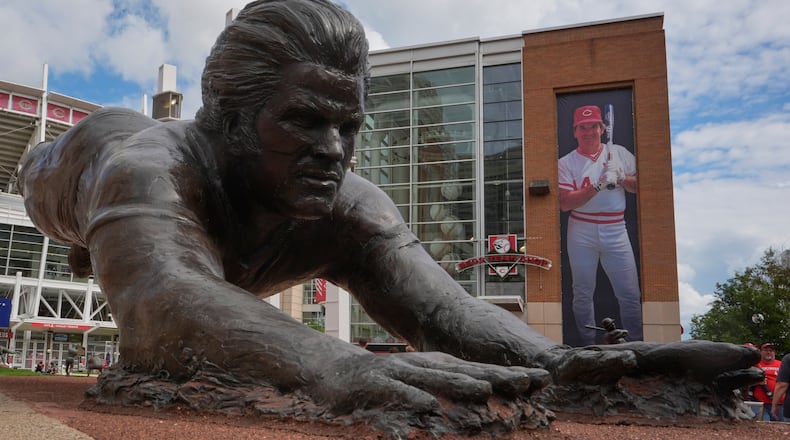And I said, “Pete, I hate to say it, but I don’t believe it will ever happen.”
I was wrong. And I’ve never been happier to be wrong.
In a shockingly surprise decision, baseball commissioner Rob Manfred lifted the permanently ineligible ban on Rose and Shoeless Joe Jackson Tuesday.
It’s the first step, but a giant step, toward Rose landing where he has belonged for a long time, in the Cooperstown Hall of Fame with a plaque.
Rose probably has more memorabilia in the Cooperstown Museum than any other man who ever played the game, but his banishment for gambling on the game has kept him from having his visage hanging in the Plaque Gallery.
Lifting the ban doesn’t put him in the Hall of Fame, it just makes him eligible. He will have to pass the approval of two committees.
The first group, the Historical Overview Committee, will come up with eight names for a ballot and Rose must be on that ballot.
Those names will be turned over to the Classic Baseball Era Committee. If Rose’s name is one of the eight, that committee will take a vote and he must received at least 12 of the 16 votes.
The Classic Baseball Era group doesn’t meet until December of 2027, so his possible enshrinement would not be until 2028.
Manfred said that punishment of banned players ends when they die. If that’s the case, why did it take so long for Jackson’s ban to be lifted?
Baseball’s first commissioner, Judge Kennesaw ‘Mountain’ Landis banned Jackson a couple of years after Jackson’s part in the fixing on the 1919 World Series between the Cincinnati Reds and Chicago Black Sox.
Eight White Sox players were banished. Jackson was one of the most proficient players in the Series, tried to win, but he was in on the original meetings to plan the fix, but did not report it.
Manfred turned down Rose’s request for re-instatement a few years ago, but said Tuesday, “Obviously, a person no longer with us cannot represent a threat to the integrity of the game.”
Pete Rose, a threat? He was 83 when he died and had no association with baseball. Yet he remained one of baseball’s top ambassadors as a lover of the game.
And he has apologized over and over and over and, finally, after 21 years of denying he bet on the game, he ‘fessed up, admitted he sinned badly against the game.
Perhaps the undercurrent for Manfred’s decision is that baseball is deeply under the covers with professional gambling. Nearly every team offers commercials from casinos and many have casino advertising dangling on signage on the grandstand facades and on the outfield walls.
Cincinnati Reds games are telecast on the FanDuel network, a network owned by FanDuel, an online wagering app.
The Hit King, baseball’s all-time hits leader with 4,256, accepted the life-time ban imposed by commissioner Bart Giamatti in 1989 after a six-month investigation conducted by John Dowd.
When Rose accepted the life-time ban, he was under the impression that he would be able to apply for re-instatement after a year.
Giamatti said no. It was permanent and he said Rose knew it when he signed off on a life-time ban.
Giamatti, vastly overweight and a chain smoker, passed away shortly after the banishment and many blamed Rose for causing the stress that led to Giamatti’s death.
Among those was Giamatti’s successor, Fay Vincent, a very close friend to Giamatti and a man who would not even consider Rose’s re-instatement.
After Rose’s banishment, it was the Hall of Fame’s board of directors that decided that any player on the ineligible list would not be considered for enshrinement. It became known as ‘The Pete Rose Rule.’
As Rose told me, “I know they did that just to keep me out. I know I did wrong, but I can’t take that back. I’ve did (sic) everything I could to make up for it and I don’t think anybody has done more to promote the game than me. But I am forever the bad guy.”
Rose did not endear himself with the Hall of Fame staff. Every year, during Hall of Fame weekend, Rose was in Cooperstown at a shop on Main Street selling his autograph and memorabilia.
A line would stretch out the door and down the street, while at other venues Hall of Fame players doing the same thing would have no more than a dozen or so people in line.
There is no doubt, despite his personal warts and foibles, Pete Rose remained one of baseball’s all-time favorite players, even long after his playing days, and the fans showed it.
And now, finally, perhaps the power-that-be, will display the right power and place Rose where he belongs. . .with his plaque hanging in the Plaque Gallery.
About the Author
